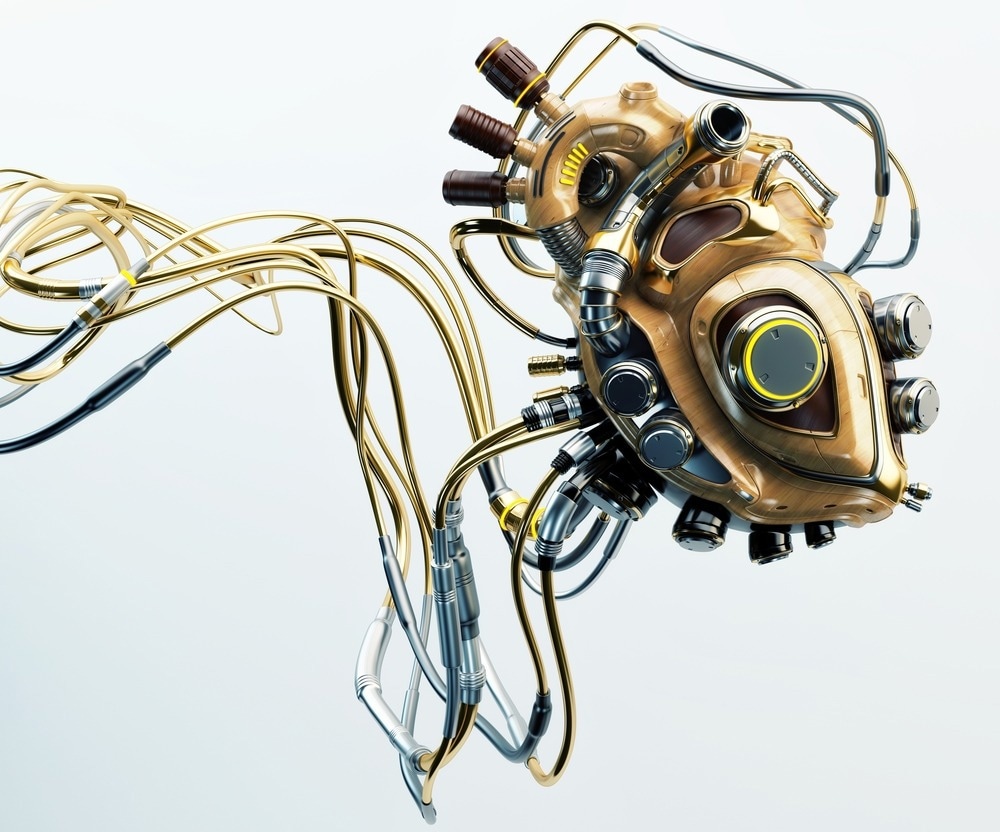Right ventricle (RV) dysfunction has become recognized as a significant factor in cardiovascular health, necessitating the development of RV-specific cardiac devices and therapies. Learn more about how a robotic RV can transform cardiac device testing.

Image Credit: Ociacia/Shutterstock.com
Introduction to Robotic RV in Cardiac Device Testing
RV dysfunction occurs when the RV is unable to maintain enough blood flow via the lungs to sufficiently feed the left ventricle.
While it can manifest suddenly due to events like massive pulmonary embolism or right-sided myocardial infarction in the intensive care unit, it often deteriorates gradually among patients with underlying chronic heart and lung conditions.
RV dysfunction, therefore, is a crucial challenge in cardiovascular medicine, requiring specialized medicines and technologies. However, standard techniques of evaluating cardiac devices for the right ventricle have drawbacks, such as cost, ethical problems related to animal studies and variability.
Robotic RV (RRV) technology entails the creation of advanced robotic devices that simulate RV function under pathologic settings.
RRV technology gives researchers a potent tool for assessing the efficacy of cardiac devices with previously unknown accuracy and dependability by simulating the complex hemodynamics of the RV under controlled laboratory conditions.
Current Challenges in Cardiac Device Testing
Conventional techniques, such as animal studies and in vitro simulations, have intrinsic constraints that reduce their efficacy.
In vitro simulators have lower concentrations of regulated hemodynamics than benchtop simulators. Patients with pulmonary hypertension or congenital heart disease are particularly susceptible to RV. In vitro simulators often neglect the complexity needed to accurately simulate real-world RV function.
Cardiovascular devices are currently evaluated via animal experiments, which are laborious to set up, costly, time-consuming, and frequently end in fatalities, raising ethical concerns. In several circumstances, animal trials also did not accurately anticipate severe human toxicity.
*This includes a lack of human and canine consent on the proarrhythmia risks of novel cardiovascular medications, as well as animal research's failure to forecast drug related concerns in the human respiratory and central nervous systems. *
Role of Robotic RV in Overcoming Testing Limitations
The effective development of an RRV is a noteworthy advancement in cardiovascular science, as reported in a recent paper published in Nature Cardiovascular Research.
The new method accurately simulates right-ventricular activity in both pathological and normal situations, with the goal of reducing the need for animal testing to assess intracardiac device hemodynamic performance while offering cost savings.
A biohybrid approach was used to produce the RRV, which combines a chemically activated endocardial scaffold and a soft robotic artificial myocardial.

Image Credit: PopTika/Shutterstock.com
Advantages of Using Robotic RV for Cardiac Device Evaluation
RRV (cardiac simulator) reproduces hemodynamics and biomechanics of the right ventricle of the heart, including free-wall septal and valve movements.
RRV serves as the main cardiac pump, replicating the appropriate hemodynamics and eliminating the need for auxiliary pulsatile pumps. Singh et al. employed a control system in the previously described investigation to pressurize the actuators at a serial delay of 20 - 50 m/s to mimic peristaltic-like RV ejection.
In addition to recreating real-time hemodynamic changes, it accurately models many types of RV dysfunction, including pulmonary arterial hypertension and tricuspid valve regurgitation.
The simulator also offers substantial advantages for tricuspid valve replacement and repair. The RRV has been validated in vivo using a porcine model, indicating its practical relevance in enhancing RV malfunction detection and offering a platform to create disease-correcting technologies.
In vivo tests using a porcine model confirmed the RRV's ability to simulate real-time cardiovascular changes, with peak systolic blood pressure reaching 32 mmHg and RV volume reduced by 62%.
Another advantage is that it works with standard imaging techniques such as echocardiography, computed tomography (CT), and magnetic resonance imaging (MRI).
Researchers can use this compatibility to study the architecture and functioning of the RV, thereby improving the comprehension of its pathophysiology.
Future Implications and Potential Transformations in Cardiac Device Testing
Innovative technology such as the RRV simulator may shed light on RV-associated disease and act as a platform for developing and assessing novel interventions and therapies.
The artificial ventricle may be programmed to replicate both healthy and sick states, providing a realistic platform for investigating right ventricular problems. The researchers also proved that it may be used to evaluate cardiac devices.
The RRV has the ability to model circumstances associated with right ventricular malfunction, such as myocardial infarction (MI), which can assist in increasing our understanding of these ailments and hasten the development of better cardiac implants.
The RRV simulator can replicate the dynamics of several clinical states, such as tricuspid valve failure, revealing its potential use in assessing repairs and replacements.
The incorporation of artificial intelligence (AI) and machine learning (ML) algorithms into RRV systems has the potential to transform cardiac device testing in the future.
These algorithms can uncover patterns, optimize device performance, and anticipate clinical outcomes by analyzing massive volumes of data generated during testing, increasing the pace of innovation in the field of cardiovascular care.
What is a Robotic Catheter?
References and Further Reading
- Van Norman, G. A. (2019) Limitations of Animal Studies for Predicting Toxicity in Clinical Trials: Is it Time to Rethink Our Current Approach? JACC: Basic to Translational Science, 4(7), pp. 845-854. doi.org/10.1016/J.JACBTS.2019.10.008
- Mumtaz, H., et al. (2022) The future of Cardiothoracic surgery in Artificial intelligence. Annals of Medicine and Surgery, p. 80. doi.org/10.1016/J.AMSU.2022.104251
- Singh, M., et al. (2023) Robotic right ventricle is a biohybrid platform that simulates right ventricular function in (patho)physiological conditions and intervention. Nature Cardiovascular Research, 2(12), pp. 1310-1326. doi.org/10.1038/S44161-023-00387-8
- Arrigo, M., et al. (2019) Right Ventricular Failure: Pathophysiology, Diagnosis and Treatment. Cardiac Failure Review, 5(3), p. 140. doi.org/10.15420/CFR.2019.15.2
- Ventetuolo, C. E., & Klinger, J. R. (2014) Management of Acute Right Ventricular Failure in the Intensive Care Unit. Annals of the American Thoracic Society, 11(5), p. 811. doi.org/10.1513/ANNALSATS.201312-446FR
- MIT engineers design a robotic replica of the heart’s right chamber | MIT News | Massachusetts Institute of Technology. Available at: https://news.mit.edu/2023/mit-engineers-design-robotic-replica-hearts-right-chamber-1208. (Accessed February 26, 2024).
- The Future of Cardiac Research: The Robotic Right Ventricle. Available at: https://medriva.com/health/healthcare/the-future-of-cardiac-research-the-robotic-right-ventricle/. (Accessed February 26, 2024).
- Singh, M., et al. (2023) Robotic right ventricle is a biohybrid platform that simulates right ventricular function in (patho)physiological conditions and intervention. Nature Cardiovascular Research, 2(12), pp. 1310-1326. doi.org/10.1038/s44161-023-00387-8
Disclaimer: The views expressed here are those of the author expressed in their private capacity and do not necessarily represent the views of AZoM.com Limited T/A AZoNetwork the owner and operator of this website. This disclaimer forms part of the Terms and conditions of use of this website.